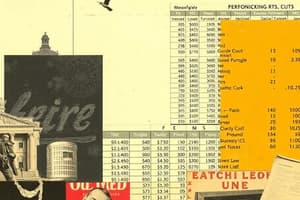Podcast
Questions and Answers
What costs count as prime costs?
What costs count as prime costs?
- Direct Materials + Manufacturing Overhead
- Direct Labor + Manufacturing Overhead
- Direct Materials + Direct Labor (correct)
- Selling, General, and Administrative Expenses
What costs count towards conversion costs?
What costs count towards conversion costs?
- Selling, General, and Administrative Expenses
- Direct Materials + Manufacturing Overhead
- Direct Labor + Manufacturing Overhead (correct)
- Direct Materials + Direct Labor
Define 'Direct Materials'.
Define 'Direct Materials'.
All the materials used directly in the production of a product.
Define 'Direct Labor'.
Define 'Direct Labor'.
Define 'Manufacturing Overhead'.
Define 'Manufacturing Overhead'.
Define 'Non-manufacturing Costs'.
Define 'Non-manufacturing Costs'.
Define 'Variable Costs'.
Define 'Variable Costs'.
Define 'Fixed Costs'.
Define 'Fixed Costs'.
Define 'Product Costs'.
Define 'Product Costs'.
Overhead Rate = Estimated overhead cost / Estimated ______
Overhead Rate = Estimated overhead cost / Estimated ______
Overhead Applied = Direct labor hours * ______
Overhead Applied = Direct labor hours * ______
What is the formula for Cost of Goods Manufactured?
What is the formula for Cost of Goods Manufactured?
What is the formula for Cost of Goods Sold?
What is the formula for Cost of Goods Sold?
Direct Materials and Direct Labor are charged to WIP Inventory.
Direct Materials and Direct Labor are charged to WIP Inventory.
Overhead (indirect materials, indirect labor, utilities) is charged to WIP Inventory.
Overhead (indirect materials, indirect labor, utilities) is charged to WIP Inventory.
Define 'Raw Material Inventory'.
Define 'Raw Material Inventory'.
Define 'Work in Process Inventory'.
Define 'Work in Process Inventory'.
Define 'Finished Goods Inventory'.
Define 'Finished Goods Inventory'.
Give an example of a company that would use process costing.
Give an example of a company that would use process costing.
Give an example of a company that typically used job order costing.
Give an example of a company that typically used job order costing.
What is the formula for Activity Rate?
What is the formula for Activity Rate?
What is the formula for Target Cost?
What is the formula for Target Cost?
What are direct labor hours and machine hours an example of?
What are direct labor hours and machine hours an example of?
Flashcards
Margin
Margin
Net Income divided by Revenue.
Prime Costs
Prime Costs
Direct Materials plus Direct Labor.
Total Manufacturing Costs
Total Manufacturing Costs
Direct Materials + Direct Labor + Manufacturing Overhead.
Conversion Costs
Conversion Costs
Signup and view all the flashcards
Direct Materials
Direct Materials
Signup and view all the flashcards
Direct Labor
Direct Labor
Signup and view all the flashcards
Manufacturing Overhead
Manufacturing Overhead
Signup and view all the flashcards
Non-manufacturing Costs
Non-manufacturing Costs
Signup and view all the flashcards
Variable Costs
Variable Costs
Signup and view all the flashcards
Fixed Costs
Fixed Costs
Signup and view all the flashcards
Period Costs
Period Costs
Signup and view all the flashcards
Product Costs
Product Costs
Signup and view all the flashcards
Overhead Rate
Overhead Rate
Signup and view all the flashcards
Overhead Applied
Overhead Applied
Signup and view all the flashcards
Cost of Goods Manufactured
Cost of Goods Manufactured
Signup and view all the flashcards
Cost of Goods Sold
Cost of Goods Sold
Signup and view all the flashcards
Conversion Costs (Method 2)
Conversion Costs (Method 2)
Signup and view all the flashcards
Estimated Direct Labor Hours
Estimated Direct Labor Hours
Signup and view all the flashcards
Predetermined Overhead Rate
Predetermined Overhead Rate
Signup and view all the flashcards
Applied Manufacturing Overhead
Applied Manufacturing Overhead
Signup and view all the flashcards
Labor Costs
Labor Costs
Signup and view all the flashcards
Indirect Labor
Indirect Labor
Signup and view all the flashcards
Manufacturing Overhead Credit Balance
Manufacturing Overhead Credit Balance
Signup and view all the flashcards
Manufacturing Overhead Debit Balance
Manufacturing Overhead Debit Balance
Signup and view all the flashcards
Raw Material Inventory
Raw Material Inventory
Signup and view all the flashcards
Work in Process Inventory
Work in Process Inventory
Signup and view all the flashcards
Finished Goods Inventory
Finished Goods Inventory
Signup and view all the flashcards
Process Costing
Process Costing
Signup and view all the flashcards
Job Order Costing
Job Order Costing
Signup and view all the flashcards
Activity Rate
Activity Rate
Signup and view all the flashcards
Study Notes
- Margin is the Net Income divided by Revenue.
- Prime Costs are Direct Materials plus Direct Labor.
- Total Manufacturing Costs include Direct Materials, Direct Labor, and Manufacturing Overhead.
- Conversion Costs are the sum of Direct Labor and Manufacturing Overhead, representing the cost to convert raw materials to finished goods.
- Direct Materials are materials directly used in production, focusing on significant components; minor parts are considered manufacturing overhead.
- Direct Labor is the labor directly involved in production, such as factory worker wages; it excludes salaries of presidents and line supervisors.
- Manufacturing Overhead includes all production costs besides direct materials and direct labor (e.g., warehouses, factories, indirect labor, supervisor salaries).
- Non-manufacturing Costs/NA costs encompass all company costs not related to production like advertising, depreciation for salesperson vehicles, president's salary, and commissions.
- Variable Costs change with activity level, fluctuating with production volume (e.g., materials, utilities, wages, commissions).
- Fixed Costs remain constant regardless of activity level changes (e.g., rent, depreciation, insurance, advertising, salary).
- Period Costs are not directly involved in production and are expensed immediately (e.g., selling, administrative, interest expenses, depreciation of sales vehicles, sales commissions).
- Product Costs directly relate to production of a product and include direct materials, direct labor, and manufacturing overhead.
Overhead Applied
- Step 1 involves calculating the overhead rate.
- Overhead Rate = Estimated overhead cost / Estimated labor hours
- Step 2 applies the overhead.
- Overhead Applied = Direct labor hours * Overhead Rate
- Direct Materials (if not given) = Total Manufacturing costs – Direct Labor – Manufacturing Overhead Applied
- Cost of Goods Manufactured = Manufacturing Costs + Beginning Work in Process Inventory – Ending Work in Process Inventory.
- Beginning Work in Process Inventory = Cost of Goods Manufactured – Manufacturing Costs + Ending Work in Process Inventory
- Ending Work in Process Inventory = Manufacturing Costs + Beginning Work in Process Inventory – Cost of Goods Manufactured
- Cost of Goods Sold = Cost of Goods Manufactured + Beginning Finished Goods Inventory – Ending Finished Goods Inventory
- Beginning Finished Goods Inventory = Cost of Goods Sold – Cost of Goods Manufactured + Ending Finished Goods Inventory
- Ending Finished Goods Inventory = Cost of Goods Manufactured + Beginning Finished Goods Inventory – Cost of Goods Sold
- Direct Labor = Conversion Costs / Percentage given in the problem
- Conversion Costs= Manufacturing Costs – Direct Materials
- Estimated Direct Labor Hours = Direct Labor / Estimated Rate
- Predetermined Overhead Rate = Estimated Manufacturing Overhead / Estimated Direct Labor Hours
- Applied Manufacturing Overhead = Predetermined Overhead Rate * Actual hours
- Labor Costs = Direct Labor + Indirect Labor
- Salaries and Wages Payable = Work in Process Inventory + Manufacturing Overhead + Selling, General, Administrative expenses + Salaries.
- Indirect Labor: Labor that was not directly involved in the production of a product.
- If Manufacturing Overhead has a Credit Balance, it is Overapplied Manufacturing Overhead, decrease Cost of Goods Sold.
- If Manufacturing Overhead has a debit balance, it is Underapplied Manufacturing Overhead, increase Cost of Goods Sold.
- Direct Materials and Direct Labor are charged to WIP Inventory.
- Overhead is charged to Manufacturing Overhead instead of WIP Inventory.
- Applied Manufacturing Overhead is charged to WIP.
- Raw Material Inventory: Raw materials that have not been used in production.
- Work in Process Inventory: Raw materials that are converted/used in the production process.
- Finished Goods Inventory: Finished products that have not been sold.
- Raw Material Inventory flows into Work in Process Inventory then into à Finished Goods Inventory.
- Process Costing: Costing used by companies that make standardized/homogenous products.
- Job Order Costing: Costing used by companies that offered customized or unique products or services.
Journal Entries Example
- When raw materials are bought:
- Debit: Raw Inventory
- Credit: A/P
- When transferring raw materials to the factory floor:
- Debit: Work In Process (WIP) Inventory
- Credit: Raw Materials Inventory
- Upon product completion:
- Debit: Finished Goods Inventory
- Credit: WIP Inventory
Chapter 4 Formulas
- Activity Rate = Total Activity Cost / Total Cost Driver
- Target Cost = Market Price – Target Profit
- Cost Driver = Engineering hours + Product Assigned + Machine hours
- Unit Cost = Overhead Assigned / # of units + Direct Materials + Direct Labor
- Traditional method: cost driver = estimated unit cost
- Estimated Unit Cost * hours = total production costs
- Gross Profit Per Unit = Average selling price – Manufacturing Cost per unit
- ABC method: Individual Total Cost / Total Hours using machine= exact unit production cost.
- Exact unit production cost * hours = exact machine production costs for standard or deluxe
- ABC is more time consuming than traditional, but you receive a more accurate answer
Studying That Suits You
Use AI to generate personalized quizzes and flashcards to suit your learning preferences.




